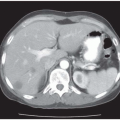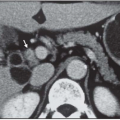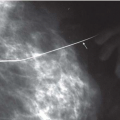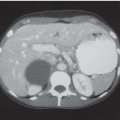Case 78
Presentation: Case 78A
A 25-year-old woman who is a medical student presents with a history of routine physical examination performed at the time of entry to medical school. The patient is totally asymptomatic. The routine physical examination reveals a well-defined mass involving the right lobe of the thyroid. It measures 2.5 × 2.5 cm, moves very well with swallowing, and does not appear to be fixed to the trachea or surrounding structures. The trachea is central. Careful examination of the neck does not reveal any suspicious lymphadenopathy. Examination of the oral cavity, larynx, and pharynx is within normal limits. Both vocal cords are normal and mobile. There is no past history of thyroid disease or history of radiation as a child. The family history does not define any thyroid-related problem or thyroid cancer in the family. The patient does not give any history of radiation to the neck as a child.
Differential Diagnosis
This young female patient presents with a mass in the thyroid, which measures approximately 2.5 cm and does not appear to be fixed to the surrounding structures. This is a classical presentation of a solitary thyroid nodule. The differential diagnosis includes multinodular goiter with a prominent right thyroid nodule, Hashimoto thyroiditis, carcinoma of the thyroid, medullary carcinoma of the thyroid, and benign follicular adenoma of the thyroid.
The most common thyroid swelling in a young woman is a classic presentation of solitary thyroid nodule. Even though the patient is totally asymptomatic, this requires further investigations. The differential diagnosis includes a benign follicular lesion, such as follicular adenoma, or it may be follicular carcinoma based in capsular invasion, which is documented only in the permanent histology after surgery (Table 78.1). The patient has no history of radiation, which is generally a major carcinogenic etiology for development of thyroid cancer. A solitary thyroid nodule is quite a rare presentation for Hashimoto thyroiditis. The diagnosis of medullary carcinoma of the thyroid should be rare, but needs to be considered, and obtaining a careful family history is crucial. If any of the family members had medullary carcinoma of the thyroid, this would be the most important history. Metastatic tumors to the thyroid at this age are extremely rare and need not be considered in the differential diagnosis. History of residence of the patient in an endemic area is important to distinguish other conditions such as nodular goiter. However, in a young woman with a solitary thyroid nodule that is firm, the most important diagnosis is to exclude papillary carcinoma of the thyroid.
A variety of diagnostic tests are available in this patient including blood studies, imaging studies, and needle biopsy. The question is not what is available, but what is necessary. The most important diagnostic study in this patient is fine-needle aspiration biopsy. In a patient who presents with a well-defined solitary thyroid nodule, a fine-needle aspiration biopsy would be the first diagnostic study. The accuracy of fine-needle aspiration biopsy is over 95% and it can be reliably used in the evaluation and management of this patient.
Table 78.1: Various Stages of Follicular Lesions | ||||||||||
|---|---|---|---|---|---|---|---|---|---|---|
|
Case Continued
The fine-needle aspiration biopsy in this patient was reported to show papillary carcinoma of the thyroid.
Diagnosis and Recommendation
Other diagnostic tests include thyroid function tests. Most of the patients with solitary thyroid nodules are euthyroid, and thyroid function tests are rarely helpful. However, the thyroid-stimulating hormone (TSH) value may be helpful to rule out a “hot” or hyperfunctioning thyroid nodule. If the TSH value is very low, thyroid scan is indicated to see if the patient has a “hot” thyroid nodule. However, the workup probably will remain the same in a well-defined, firm, solitary thyroid nodule. The incidence of multinodular goiter in a patient who presents with a solitary thyroid nodule is quite small and the patient can be evaluated with an ultrasound. The ultrasound is a very useful diagnostic tool to define the size of the thyroid nodule and to see if any other nodules are present in the opposite lobe. It also defines any enlarged or suspicious lymph nodes. Ultrasound is also very helpful to define whether there are any punctate calcifications suggestive of papillary carcinoma of the thyroid or pericapsular hypervascularity. These investigations are quite helpful. An ultrasound-guided fine-needle aspiration biopsy can also be performed to direct the needle in the most suspicious area of the nodule. Thyroid scan is rarely of any help. It will define this nodule to be cold, which is hypofunctioning thyroid nodule, and does not help make a decision whether it is benign or malignant. The incidence of malignancy in cold thyroid nodules is approximately 16% to 20%. Similarly, the incidence of malignancy in solid thyroid nodules is between 16% and 20%. These investigations do not define whether the patient has a benign or malignant process. However, the fine-needle aspiration biopsy will be very suspicious. The other imaging studies, such as computed tomography (CT) scan and magnetic resonance imaging (MRI), are rarely of help in a well-defined solitary thyroid nodule. These investigations are of great help in patients who present with large thyroid nodules or large substernal pathologies.
Routine use of calcitonin assay is not helpful unless the family history is strongly suggestive of medullary carcinoma of the thyroid, or the patient has any other suspicious findings such as unexplained hypertension or any other characteristics suspicious for multiple endocrine neoplasia (MEN). Once the diagnosis of papillary carcinoma is made with fine-needle aspiration biopsy, the patient should be considered for surgery. In a young woman, it is always important to rule out pregnancy prior to any surgical intervention. Careful preoperative evaluation of the vocal cords is essential. Indirect laryngoscopy with a mirror will generally define the condition and mobility of the vocal cords. However, if the mirror examination is difficult, fiberoptic laryngoscopy should be performed. Evaluation of the vocal cords for their mobility should be routine in the evaluation and management of thyroid nodules both preoperatively and postoperatively. An informed consent should be obtained after discussing the complications of surgery, such as scar formation, hematoma, hoarseness of voice, inability to raise the voice, and need for calcium supplementation, depending upon the extent of surgery. The overall incidence of these complications is <3% to 4%; however, some of these complications can be quite distressing to the patient, especially hoarseness of voice, or the inability to raise the voice may jeopardize the patient’s singing abilities. If the patient undergoes total thyroidectomy, there is approximately a 10% to 15% chance of developing temporary hypoparathyroidism and a 2% to 3% chance of developing permanent hypoparathyroidism. These issues need to be discussed with the patient in detail.
▪ Approach
This patient with a papillary carcinoma of the thyroid that is 2.5 cm at the age of 25 falls into classic low-risk thyroid cancer where the overall chance of a good outcome exceeds 98% to 99%. It is important to discuss the surgical approach to this problem along with complications. The surgical approach includes thyroid lobectomy or total thyroidectomy. There is no role for a subtotal thyroidectomy in patients suspected to have papillary carcinoma of the thyroid. The patient needs a detailed explanation of the controversy in relation to the management of thyroid nodule and the extent of thyroidectomy. The issues related to lobectomy versus total thyroidectomy need to be discussed with the patient and with the referring endocrinologist. Most of these patients will do extremely well with lobectomy alone. The major advantage of lobectomy includes a lower incidence of complications related to parathyroid and recurrent laryngeal nerve injury. The advantages of total thyroidectomy include ease of follow-up of the patient with thyroglobulin levels and ability to perform radioactive iodine dosimetry and
iodine ablation. However, in young patients with low risk, there is hardly any need for submitting these patients to radioactive iodine ablation. The overall outcome in these patients is so good that any additional treatment is essentially overtreatment. It is important to discuss all these issues with the patient, and even though a physician will give definite recommendations, it is important that the patient is made aware of the pros and cons of the treatment approaches.
iodine ablation. However, in young patients with low risk, there is hardly any need for submitting these patients to radioactive iodine ablation. The overall outcome in these patients is so good that any additional treatment is essentially overtreatment. It is important to discuss all these issues with the patient, and even though a physician will give definite recommendations, it is important that the patient is made aware of the pros and cons of the treatment approaches.
▪ Surgical Approach
The patient is placed in the supine position with the neck in extension. A skin crease neck incision is made and subplatysmal flaps are created. The midline is identified and the strap muscles are elevated off the thyroid gland and retracted laterally. The middle thyroid vein is divided and ligated, which allows the thyroid lobe to be retracted medially. The branches of the superior thyroid are individually ligated and divided to avoid injury to the superior laryngeal nerve. The branches from the inferior thyroid artery are also divided while preserving the parathyroid glands. The recurrent laryngeal nerve is identified and preserved. The inferior thyroid vein is ligated. The thyroid lobe is dissected off the trachea along with the isthmus. The opposite thyroid lobe is carefully palpated, and if no nodules are felt, then the thyroid lobectomy and isthmusectomy is completed. If a total thyroidectomy is to be performed, then the same dissection is completed on the opposite side.
Discussion
Well-differentiated thyroid carcinoma is probably the most rapidly increasing thyroid cancer in the United States. This may be related more to the early diagnosis of these lesions with incidentalomas than a true increase in the incidence of thyroid cancer. Approximately 24,000 new patients with thyroid cancer are seen every year in the United States. There clearly is an increasing incidence of thyroid cancer in women; however, what is interesting is the mortality from thyroid cancer has essentially remained unchanged over the past 25 years. Approximately 1,000 patients die of thyroid cancer every year in the United States. However, a majority of the deaths are related to either anaplastic or medullary thyroid cancer. Death from well-differentiated thyroid cancer is quite rare, especially in young individuals. There appears to be an increasing incidence of incidentalomas diagnosed with routine evaluation of the neck with ultrasound, CT scan, or MRI. CT or MRI for other head and neck pathologies, such a motor vehicle accident, carotid problems, or chest problems, may reveal an incidental thyroid nodule. A majority of these nodules are generally benign; however, they do require further evaluation. Generally, nodules smaller than 1 cm can be observed and followed closely. However, if there is a clinical concern, an ultrasound-guided fine-needle aspiration biopsy, which is quite helpful, should be considered. Recently, there appears to be an increasing incidence of positron-emission tomography (PET) incidentalomas; PET scan being performed routinely for other malignant tumors may reveal an increased uptake in the thyroid lobe suggestive of incidental thyroid nodularity. These patients need to be evaluated further with the use of ultrasound and ultrasound-guided needle biopsy. If the ultrasound-guided needle biopsy is negative, the patient can be observed and followed on a routine basis. Obviously, if the fine-needle biopsy is suspicious or reported to be malignant, the patient needs surgical intervention.
Stay updated, free articles. Join our Telegram channel

Full access? Get Clinical Tree








